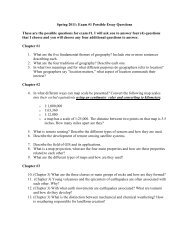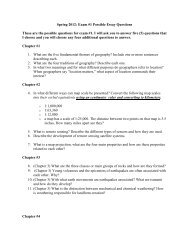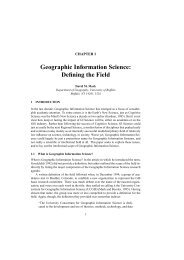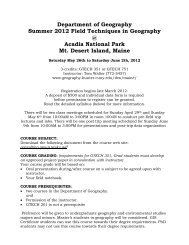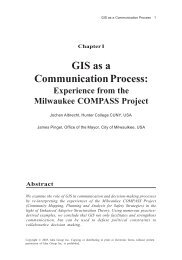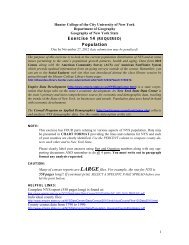Chapter 9 Weather Patterns
Chapter 9 Weather Patterns
Chapter 9 Weather Patterns
Create successful ePaper yourself
Turn your PDF publications into a flip-book with our unique Google optimized e-Paper software.
<strong>Chapter</strong> 9 <strong>Weather</strong> <strong>Patterns</strong><br />
1) The general term applied to warm air moving up over a colder air mass is:<br />
A) overrunning.<br />
B) warm front.<br />
C) cold front.<br />
D) orographic lifting.<br />
2) If a warm front is approaching, you can expect<br />
A) falling temperatures.<br />
B) rising temperatures.<br />
C) clearing skies.<br />
D) calm winds.<br />
3) In 1918, J. Bjerknes published what came to be known as the polar front theory. Which one of the following<br />
statements is correct regarding this theory?<br />
A) It was shown to be applicable only to winter storms in the Southern Hemisphere.<br />
B) The main features of the theory remain an important part of present-day meteorological thought.<br />
C) Although it was useful at the time, it is no longer a useful model.<br />
D) The polar front theory was largely incorrect from the very beginning.<br />
4) Another common term for the wave cyclone is:<br />
A) tropical cyclone.<br />
B) polar-front cyclone.<br />
C) intertropical convergence zone.<br />
D) midlatitude cyclone.<br />
5) When the center of a mature wave cyclone passes to the south, you should expect:<br />
A) generally fair weather.<br />
B) to experience a veering wind shift.<br />
C) to be influenced by an occluded front.<br />
D) absolutely nothing.<br />
6) A wind shift in a counterclockwise direction, as from east to north, is termed ________ wind shift.<br />
A) frontal<br />
B) veering<br />
C) anticyclonic<br />
D) backing<br />
7) A wind shift in a clockwise direction, as from south to west, is termed ________ wind shift.<br />
A) backing<br />
B) frontal<br />
C) veering<br />
D) cyclonic<br />
8) Middle-latitude cyclones<br />
A) have cold fronts but not warm fronts.<br />
B) travel from east to west.<br />
C) are large high-pressure systems.<br />
D) rotate counterclockwise.
9) Middle-latitude anticyclones<br />
A) rotate clockwise.<br />
B) travel from east to west.<br />
C) have cold fronts but not warm fronts.<br />
D) are large low-pressure systems.<br />
10) An area on the north side of the low-pressure center of a middle-latitude cyclone usually has this type of<br />
front for the longest period of time.<br />
A) occluded<br />
B) warm<br />
C) cold<br />
D) All three front types stay about the same amount of time.<br />
11) The strongest winds during the 1993 ʺStorm of the Centuryʺ occurred where?<br />
A) Mt. Washington, NH<br />
B) Boston, MA<br />
C) New York, NY<br />
D) Myrtle Beach, SC<br />
E) Flattop Mountain, NC<br />
12) The type of front shown on the diagram above is:<br />
A) a cold front.<br />
B) a warm front.<br />
C) an occluded front.<br />
D) a stationary front.
13) The type of weather most frequently associated with the front shown on the diagram above is:<br />
A) clear skies.<br />
B) steady, gentle rainfall.<br />
C) blizzards.<br />
D) thunderstorms and other severe weather.<br />
14) The type of front represented in the diagram above is a:<br />
A) warm-type occluded front.<br />
B) cold-type occluded front.<br />
C) cold front.<br />
D) warm front.<br />
15) Thunderstorms can be generated when a cT air mass meets an mT air mass and creates a frontal boundary<br />
called a:<br />
A) cold front.<br />
B) warm front.<br />
C) dryline.<br />
D) humidity front.<br />
16) A dryline causes uplift to occur because:<br />
A) the intruding air mass is colder and more humid than the lifted air mass.<br />
B) the lifted air mass is moister than the intruding air mass.<br />
C) the lifted air mass is dryer than the intruding air mass.<br />
D) the intruding air mass has the same low humidity as the lifted air mass.<br />
17) As a warm front approaches, which progression of clouds are you most likely to see?<br />
A) cumulus, cimulonimbus<br />
B) altostratus, cirrostratus, stratus, cumulonimbus<br />
C) cirrocumulus, cirrus, nimbostratus, stratus<br />
D) cirrus, cirrostratus, altostratus, nimbostratus
18) A ridge aloft is generally associated with<br />
A) cyclonic flow at the surface.<br />
B) anticyclonic flow at the surface.<br />
C) divergence of the jet stream.<br />
D) stormy weather.<br />
19) Tornadoes are generally associated with which type of front?<br />
A) cold front<br />
B) warm front<br />
C) stationary front<br />
D) occluded front<br />
20) A trough aloft is generally associated with:<br />
A) cyclonic flow at the surface.<br />
B) convergence of the jet steam.<br />
C) clear skies.<br />
D) anticyclonic flow at the surface.<br />
21) Which air mass type is generally found on the poleward side of a midlatitude cyclone?<br />
A) mP<br />
B) mA<br />
C) cP<br />
D) cT<br />
E) mT<br />
22) The cloud type most frequently associated with a cold front is:<br />
A) cirrus.<br />
B) cumulonimbus.<br />
C) altocumulus.<br />
D) status.<br />
E) cirrocumulus.<br />
23) The life cycle of a midlatitude cyclone generally has ________ stages.<br />
A) one<br />
B) two<br />
C) four<br />
D) six<br />
E) ten<br />
24) When speed divergence occurs in the upper atmosphere, what effect does it have on cyclogenesis?<br />
A) It can either inhibit or enhance cyclogenesis, depending on the surface air temperature.<br />
B) It inhibits cyclogenesis by preventing cyclonic flow.<br />
C) It greatly enhances cyclogenesis by increasing convergence on the surface below.<br />
D) It has no impact whatsoever on the formation of mid-latitude cyclones.<br />
25) Why does occlusion lead to the demise of a mid-latitude cyclone?<br />
A) All warm air is displaced aloft, so the surface temperature gradient has been equalized.<br />
B) The cold front stops progressing during occlusion.<br />
C) The cold cP air mass driving the cyclone has warmed intensely.<br />
D) Occlusion stops all precipitation from occurring within the cyclone.
26) A warm front is said to exist when<br />
A) advancing warm air overrides retreating cold air.<br />
B) moving cold air overrides warmer air.<br />
C) warm air pushes underneath cold air.<br />
D) warm and cold air meet.<br />
E) invading cold air pushes underneath warmer air.<br />
27) The lifting of air and the resulting formation of clouds and rain is more gentle (gradual) for a<br />
A) cold front.<br />
B) occluded front.<br />
C) warm front.<br />
D) divergence zone.<br />
E) mesocyclone.<br />
28) The more violent nature of weather produced by a cold front can be attributed to which two factors?<br />
A) the gradual slope and fast forward motion of the front<br />
B) the steep slope and fast forward motion of the front<br />
C) the gradual slope and slow forward motion of the front<br />
D) the steep slope and slow forward motion of the front<br />
29) The approximate lifetime of a wave cyclone is<br />
A) a month.<br />
B) 10 - 24 hours.<br />
C) 1 - 2 days.<br />
D) 10 - 14 days.<br />
E) a few days to a week.<br />
30) Why is the number and intensity of wave cyclones greatest during the late fall, winter and spring months?<br />
A) Temperature contrasts are greater.<br />
B) Temperatures are below freezing.<br />
C) Density of the air is greatest.<br />
D) Air is drier then.<br />
E) Meteorologists do not know.
31) After a cold front passes, which of these does not usually occur?<br />
A) wind direction shift<br />
B) marked temperature drop<br />
C) drop in relative humidity<br />
D) clearing skies<br />
E) falling barometer<br />
32) Which of these best describes the reason most high pressure systems bring clear skies?<br />
A) high temperatures aloft<br />
B) sinking air aloft<br />
C) rising air aloft<br />
D) cold air near the surface<br />
E) low temperatures aloft<br />
33) The width or horizontal extent of a typical mid-latitude low pressure system would be<br />
A) 50 - 100 km.<br />
B) 5 - 10 km.<br />
C) 500 - 1000 km.<br />
D) 10,000 km.<br />
E) 20,000 km.<br />
34) The development of major winter storms in the midwest depends strongly on<br />
A) rainfall amounts during the previous fall.<br />
B) wind speed aloft.<br />
C) wind speed near the surface.<br />
D) amount of snow already on the ground.<br />
E) air mass contrasts.<br />
35) Which of these is common to both cold and warm fronts?<br />
A) divergence of surface winds<br />
B) light to calm winds<br />
C) lifting of warm air over cold<br />
D) decreasing precipitation rates<br />
E) steady barometer readings<br />
36) An approaching wave cyclone would be indicated by a ________ barometer reading.<br />
A) slowly rising<br />
B) very low<br />
C) rapidly falling<br />
D) high<br />
E) variable, rising then falling<br />
37) What is the cause-and-effect relationship between the pattern of upper-level winds and surface low- and<br />
high-pressure systems?<br />
A) Surface systems depend primarily on wind speeds at upper levels.<br />
B) Upper level wind patterns strongly control the origin and development of surface systems.<br />
C) Surface lows decrease upper level wind speeds, surface highs increase them.<br />
D) There is no strong or consistent relationship.<br />
E) Surface systems control the upper level wind patterns.
38) The wind direction in a low pressure system is<br />
A) from the east.<br />
B) from the northwest.<br />
C) from the north.<br />
D) from the south.<br />
E) dependent on your location relative to the storm center.<br />
39) Compared to other types of fronts, the weather associated with a cold front usually<br />
A) covers more area.<br />
B) involves less precipitation.<br />
C) does not involve thunderstorms.<br />
D) is less violent but of longer duration.<br />
E) is more violent but of shorter duration.<br />
40) The energy of a mid-latitude cyclone comes mainly from<br />
A) ocean water.<br />
B) Earthʹs interior.<br />
C) sinking cold air and rising warm air.<br />
D) greenhouse effect.<br />
E) clouds.<br />
41) If you were 200 kilometers ahead of the surface position of a warm front, you would find the frontal surface<br />
at a height of ________ km overhead.<br />
A) 1<br />
B) 1.5<br />
C) 2.5<br />
D) 2<br />
E) 0.5<br />
42) On a weather map, ________ fronts are shown with triangular points on one side of the front and semicircles<br />
on the other.<br />
A) cold<br />
B) stationary<br />
C) occluded<br />
D) warm<br />
43) Rain long foretold, long last; short notice, soon past. The FIRST FIVE words of this weather proverb:<br />
A) refer to a warm front.<br />
B) refer to an anticyclone.<br />
C) refer to the formation of cumulonimbus clouds.<br />
D) have no basis in fact.<br />
E) refer to a cold front.<br />
44) The ʺStorm of the Centuryʺ struck in the winter of<br />
A) 1988.<br />
B) 1888.<br />
C) 1993.<br />
D) 1933.<br />
E) 1975.
45) The ʺStorm of the Centuryʺ had its origins in<br />
A) the North Atlantic.<br />
B) Siberia.<br />
C) northern Canada.<br />
D) the Gulf of Mexico.<br />
E) the Rocky Mountains.<br />
46) Compared to warm fronts, cold fronts have<br />
A) the same gradient and a faster advance rate.<br />
B) the same gradient and the same advance rate.<br />
C) a shallower gradient and a slower advance rate.<br />
D) a steeper gradient and a faster advance rate.<br />
E) a shallower gradient and the same advance rate.<br />
47) The arrival of a cold front brings<br />
A) mild weather.<br />
B) gentle rains.<br />
C) higher temperatures.<br />
D) cumulonimbus clouds.<br />
E) stationary winds.<br />
Refer to the diagram of a mature wave cyclone.<br />
48) Of the stations listed below, which one most likely has the least rain and cloud cover?<br />
A) point A<br />
B) point H<br />
C) point B<br />
D) point I<br />
E) point G<br />
49) Line A-D probably represents:<br />
A) a cold front.<br />
B) an occluded front.<br />
C) a warm front.<br />
D) a stationary front.
50) A low-flying aircraft heading from point J to point H would most likely experience which of the following<br />
changes in wind direction?<br />
A) NE to N to NW<br />
B) E to W to NE<br />
C) N to S to W<br />
D) SW to SE to NE<br />
E) SE to SW to NW<br />
51) Which of the stations listed below should have the highest temperature?<br />
A) point E<br />
B) point J<br />
C) point H<br />
D) point F<br />
E) point A<br />
52) Which of the following best represents the wind direction at point H?<br />
A) SE<br />
B) NW<br />
C) SW<br />
D) E<br />
E) NE<br />
53) The lowest pressure would be found at which one of the following points?<br />
A) point E<br />
B) point B<br />
C) point J<br />
D) point A<br />
E) point D<br />
54) Line A-B represents:<br />
A) a warm front.<br />
B) an occlusion.<br />
C) an isobar.<br />
D) a cold front.<br />
E) none of these<br />
55) Cyclogenesis refers to the birth of a cyclone.<br />
Answer: True False<br />
56) Cold fronts generally travel faster than warm fronts.<br />
Answer: True False<br />
57) Cyclonic winds are always counterclockwise in the northern hemisphere.<br />
Answer: True False<br />
58) Surface low-pressure systems usually develop in conjunction with a ridge aloft.<br />
Answer: True False<br />
59) The region between the warm front and cold front of a wave cyclone is the warm sector.<br />
Answer: True False
60) Downstream from a ridge aloft, the wind direction is northwest.<br />
Answer: True False<br />
61) Straight west-to-east winds aloft cause maximum cyclone development.<br />
Answer: True False<br />
62) Freezing rain and/or sleet occur most often with a cold front.<br />
Answer: True False<br />
63) Ridges and troughs are features of the upper level wind pattern.<br />
Answer: True False<br />
64) Frontal systems cause clouds by adding moisture to the air.<br />
Answer: True False<br />
65) The prevailing wind direction for an anticyclone is from the east.<br />
Answer: True False<br />
66) Thunderstorms are most common along a cold front.<br />
Answer: True False<br />
67) Surface winds for an anticyclone are convergent.<br />
Answer: True False<br />
68) Much less study has been devoted to anticyclones as compared to cyclones.<br />
Answer: True False<br />
69) Thermal lows are primarily a wintertime phenomenon in the American Southwest.<br />
Answer: True False<br />
70) When surface cyclones form, they almost invariably occur just ahead of an upper air ridge.<br />
Answer: True False<br />
71) Speed divergence helps maintain surface lows.<br />
Answer: True False<br />
72) Occluded fronts characterize the beginning stages of a middle latitude cyclone.<br />
Answer: True False<br />
73) The term cyclogenesis refers to the decay of a cyclone.<br />
Answer: True False<br />
74) Warm-type occluded fronts are the most common type of occluded front to form east of the Rockies.<br />
Answer: True False<br />
75) Cold fronts are steeper than warm fronts.<br />
Answer: True False<br />
76) Middle-latitude cyclones typically develop along segments of the polar front.<br />
Answer: True False
77) Under certain conditions, a cold front can be forced aloft by a warm front.<br />
Answer: True False<br />
78) The first sign of an approaching warm front is the appearance of cirrostratus clouds.<br />
Answer: True False<br />
79) When a warm front passes, temperature rises and the wind usually shifts.<br />
Answer: True False<br />
80) Middle-latitude cyclones die out once all the warm air has risen aloft.<br />
Answer: True False<br />
81) Generally, a change in wind direction from southwest to northwest means bad weather will come soon.<br />
Answer: True False<br />
82) Shearing of air between two air masses forms waves crucial to cyclogenesis.<br />
Answer: True False<br />
83) Cyclones usually form alone, although sometimes they are associated with anticyclones.<br />
Answer: True False<br />
84) Most cyclones and anticyclones are generated by upper-level air flow.<br />
Answer: True False<br />
85) Typically, upper-level air flow is slower over anticyclones than over cyclones.<br />
Answer: True False<br />
86) Cyclones usually move fastest in summer.<br />
Answer: True False<br />
87) Cyclones usually start out moving eastward, then turn northeast.<br />
Answer: True False<br />
88) Cyclones pass over Oregon more often in winter than in summer.<br />
Answer: True False<br />
89) Summer thermal lows in the desert Southwest are caused by surface heating.<br />
Answer: True False



